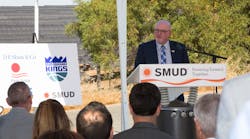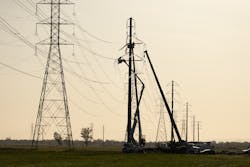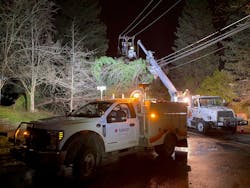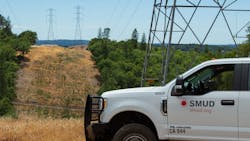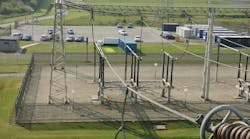When Sacramento Municipal Utility District took over responsibility for the city’s power grid from Pacific Gas & Electric Co. in 1946, it was the culmination of decades of wrangling in the courts and the political battles that followed the 1923 vote to establish a municipal utility. One hundred years after that vote, SMUD is the sixth largest utility of its kind, with detailed plans ready for the future of electricity delivery.
Chief Operating Officer Frankie McDermott said SMUD has made big moves to cut carbon from its electric supply by 2030 and the utility plans to share its knowledge at T&D World Conference and Exhibition, Sept. 12-14 in Sacramento.
“SMUD is partnering with T&D World because of the value it brings to the industry. As we work to decarbonize, we rely on new and emerging technologies. T&D World is at the forefront of those technologies as we work to find affordable and scalable solutions to a zero-carbon economy,” McDermott said. “We want to share our best practices and what we’ve learned along the way, so other utilities can move toward a carbon-free electric supply.”
The utility’s effort to address the challenges of climate change and mitigate its impacts on the Sacramento region is among the most serious tasks SMUD has before it, McDermott said.
The string of January storms was unlike anything SMUD or the Sacramento area experienced in recent memory, with the region seeing hurricane-force winds. Those heavy winds and rains caused “unprecedented” storm damage to the local power grid, with 599,000 customers seeing power outages. However, more than 90% of those customers were restored in less than 24 hours.
“To put it in perspective, the first 10 days of 2023 saw 1,200 downed wires — four times the number in 2008, which was previously our most damaging storm. There were more than 2,300 outages — double the number in the 2008 storm,” he said.
He added that SMUD needed to replace more than 425 poles, compared to 140 in 2008, as well as respond to more than 1,000 tree and vegetation issues – most of which required a tree crew to clear a hazard before line crews could begin repairing power grid equipment.
Throughout this outage restoration mobilization, SMUD had over 100 crews working in the field around the clock including 39 external crews, contract and mutual aid crews. This is a larger mobilization than the utility has ever had to carry out, he said.
“Our Emergency Operations Center was activated to help coordinate our response,” he said. “Our employees managed switching operations, made sure our crews had the equipment they needed, took more than 35,000 customer calls, reached out to support our customers, gathered new equipment, dispatched crews, planned vegetation work, re-routed electrical loads and responded to media and social media inquiries and more.”
The growing severity of storms and other weather conditions across the West and the country are a challenge to many utilities, and underscore the need to build resilient, reliable and renewable electric grids, he said.
“We must still prioritize safe and reliable electricity, while at the same shifting to renewable energy. We must make a paradigm shift to zero carbon for the long-term health of our communities and economies,” he said.
Zero-Carbon Plan
McDermott calls SMUD’s 2030 Zero Carbon Plan the most aggressive carbon reduction plan by any large utility in the country, adding that it will completely eliminate carbon from its electricity supply by 2030.
SMUD’s plan consists of:
- tripling its renewable energy resources and supporting customer owned resources like solar and batteries.
- electrifying the building and transportation sectors.
- repurposing natural gas plants and bringing to scale new technologies like virtual power plants and vehicle to grid technology.
“This plan is really comprehensive. We are taking a community benefits approach and ensuring that we do so in an affordable way so we can all benefit in a new carbon free economy,” he said.
The utility’s leadership believes it can get about 90% of the way to its zero-carbon goal with current technologies while simultaneously maximizing community benefits.
“This is key for us. We want to do all this while keeping rates below inflation, providing clean technology jobs, improving overall regional health and doing so in an equitable manner. We can’t leave any community behind while we make this transition to a carbon free economy,” he said.
Low Carbon Investments
The remaining 10% of carbon reductions, however, will be the most challenging. Those gains will require partnerships with local, state and federal leaders on a variety of projects that SMUD may be able to scale, he said.
This could include applications such as virtual power plants and vehicle to grid technology. The utility also recognizes it will need to investigate technologies not currently in its portfolio to reach the final 10% of emission reductions.
“We are investigating carbon capture and storage as a short-term bridge to meet our goals. Though green hydrogen holds promise, it won’t be available at scale by 2030, so it’s more about fuel blending in our natural gas plants. Long-duration energy storage, carbon capture, hydrogen and demand response programs are all tools that are needed to help us reach our goal,” he said.
“Optimizing these resources will be critical to ensure customers, the utility, the grid and the community all benefit. That’s where ADMS and DERMS come in,” he said.
In September of last year, SMUD launched its ADMS and Phase 1 of DERMS. These technologies will allow SMUD to transform its grid from a one-way street to a multi-directional grid, he said.
Phase 1 of DERMS gives SMUD visibility into customer-owned distributed resources such as smart thermostats, batteries and electric vehicles. Phases 2 and 3 will help dispatch these resources to help address grid conditions.
“It will also allow us to leverage customer resources for economic performance – providing benefits to customers and to SMUD,” he said.
Using Solar Precisely
A common problem for utilities that manage service territories where customers like to use rooftop solar arrays is some customers wish to generate more solar than the grid is equipped to handle. In February 2022, SMUD went live with PRECISE (PREconfiguring and Controlling Inverter SEt-points), a tool that helps SMUD’s planning engineers analyze local grid impacts from PV resources.
“PRECISE is a cutting-edge PV interconnection evaluation tool that enables utilities to cost effectively host more solar,” he said. “This project was the first automation of the technical interconnection evaluation process of its kind, and one that could serve as a template for many utilities that wish to automate the increasing challenge of evaluating new interconnection requests.”
“In these scenarios, planning engineers can work with customers on a solution that enables the PV system to interconnect successfully,” he said. “Now that PRECISE has linked the diverse utility datasets (e.g., meter data, GIS, interconnection applications) needed for automated evaluation of new distributed energy resources, PRECISE could now be applied to large commercial solar sites, battery energy storage, or to evaluate the impact of electric vehicles as they come on to the network.”
EV Impacts
California is an early adopter state for electric vehicles, and this is another area where a careful balance between decarbonization and reliability has to be struck. For its part, SMUD plans for 288,000 light duty EVs and 27,000 medium and heavy duty EVs to be used in its service territory by 2030.
“As for load growth, we are forecasting that EVs will represent over 30% of new load growth over the next 20 years, where 1 in 3 kWh that SMUD sells by 2040 is forecasted to be coming from an EV,” he said.
SMUD is taking steps now to prepare to support the expected rapid growth of EVs, both from residential customers as well as commercial, industrial and institutional customers who may be planning electric fleets. This includes concentrating on charging and the grid infrastructure to support it as well as partnering with customers and other entities, which will be key to preparing for mass EV adoption.
“We’ve done analysis over the years to understand how we need to plan our distribution grid infrastructure to support the evolution of EV charging needs. As we look towards the increasing number of EVs, the higher charging capacity options for customers, and the growth of medium- and heavy-duty vehicle electrification, we are completing comprehensive grid impact analyses,” he said.
SMUD is also looking at customer charging patterns and how it can partner with customers to influence charging behavior in a way that benefits them financially while supporting the grid during times of peak demand.
“We have customers enrolled in a managed charging pilot now, which provides important insights and data,” he said.
“We are making significant investments in our grid. And we know that if we can partner with our customers to manage their charging in ways that benefit the grid and reduce grid impacts, we can share in that value with our customers. Managed properly, EVs can help with grid reliability, and integrating more renewables,” he said.
Virtual Solutions
Developing technologies such as virtual power plants can be game changers during those times when the power grid is under the most stress. VPP applications could help SMUD and other utilities take full advantage of customer-owned resources by grouping them as a dispatchable, remotely controlled resource to help forestall outages.
SMUD recently launched a residential virtual power plant program called My Energy Optimizer Partner+ program. The project is intended to enable customers to share their solar and storage benefits with their entire community.
““Virtual Power Plants allow us to tap into customer resources for capacity instead of relying upon traditional natural gas-generation and/or less clean options. We recognize that partnering in our customer-owned investments provides a significant benefit to the community and we provide generous incentives for those customers who choose to partner with us,” he said.
By becoming a partner in this program, a customer can receive up to a $2,500 one-time incentive for a battery storage systems and receive ongoing performance payments.
A Wildfire-Safe Grid
The Golden State has unfortunately become synonymous with a practically year-round wildfire season that local, state and federal authorities, as well as utilities, have to prepare for year-round. Although SMUD’s service territory is largely urban and not deemed to be high risk for wildfires, the utility still operates a system of transmission lines through El Dorado County to its Upper American River Project (UARP), which integrates hydroelectricity into its power grid.
“Safety is our top priority,” he said. “We patrol and maintain 1,000 acres in the UARP and more than 3,800 miles of overhead distribution lines in our service territory.”
For decades, SMUD has had a robust vegetation management program in place that trims trees and other vegetation around power lines – both within its service territory as well as in the UARP.
SMUD also builds in firebreaks around transmission lines and prunes more than 70,000 trees annually to help maintain safety and reliability around lines, poles and transformers.
“We have many methods that help us to monitor our lines including LiDAR technology, aerial inspections, ground patrols, infrared inspections, x-ray splicing and more. We use digital technology to monitor trees around our transmission lines so we can identify potential safety concerns before they happen and negotiate with property owners to manage potentially problematic vegetation outside of our rights-of-way. We can also de-energize our lines in an emergency if needed,” he said.
SMUD works continually to mitigate fire risk with tools such as real time monitoring weather stations. The utility also runs distribution wires underground, replaces fusing and arresters with non-spark emitting equipment, and installs covered conductors and utilize ductile-iron and steel poles.
“We have had a robust wildfire mitigation plan in place for many years that we regularly review with our stakeholders to ensure we are in compliance with changing regulations,” he said.
SMUD also uses less common methods for keeping power line pathways clear of potentially damaging vegetation.
“We also utilize newer methods when managing our lands. For instance, we began using goats and sheep as an alternative to motorized mastication to help with weed and vegetation control around our power lines,” he said.
